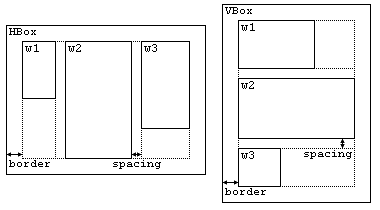1488: CF89 - B. Widget Library
[Creator : ]
Description
Vasya writes his own library for building graphical user interface. Vasya called his creation VTK(VasyaToolKit). One of the interesting aspects of this library is that widgets are packed in each other.
A widget is some element of graphical interface. Each widget has width and height, and occupies some rectangle on the screen. Any widget in Vasya's library is of type Widget. For simplicity we will identify the widget and its type. Types HBox and VBox are derivatives of type Widget, so they also are types Widget. Widgets HBox and VBox are special. They can store other widgets. Both those widgets can use the pack() method to pack directly in itself some other widget. Widgets of types HBox and VBox can store several other widgets, even several equal widgets − they will simply appear several times. As a result of using the method pack() only the li
We shall assume that the widget $a$ is packed in the widget $b$ if there exists a chain of widgets $a=c_1,c_2,...,c_k=b,\ k≥2$, for which $c_i$ is packed directly to $c_{i+1}$ for any $1≤i<k$. In Vasya's library the situation when the widget $a$ is packed in the widget $a$ (that is, in itself) is not allowed. If you try to pack the widgets into each other in this manner immediately results in an error.
Also, the widgets HBox and VBox have parameters border and spacing, which are determined by the methods set_border() and set_spacing() respectively. By default both of these options equal $0$.

For the final verification of the code Vasya asks you to write a program that calculates the sizes of all the widgets on the source code in the language of Vasyasc
Input
The first line contains an integer $n$ − the number of instructions $(1≤n≤100)$.
Next $n$ lines contain instructions in the language Vasyascript− one instruction per line. There is a list of possible instructions below.
The case matters, for example, "wiDget x" is not a correct instruction. The case of the letters is correct in the input data.
All names of the widgets consist of lowercase Latin letters and has the length from $1$ to $10$ characters inclusive. The names of all widgets are pairwise different. All numbers in the script are integers from $0$ to $100$ inclusive
It is guaranteed that the above-given script is correct, that is that all the operations with the widgets take place after the widgets are created and no widget is packed in itself. It is guaranteed that the script creates at least one widget.
Next $n$ lines contain instructions in the language Vasyasc
- "Widget [name]([x],[y])" − create a new widget [name] of the type Widget possessing the width of [x] units and the height of [y] units.
- "HBox [name]" − create a new widget [name] of the type HBox.
- "VBox [name]" − create a new widget [name] of the type VBox.
- "[name1].pack([name2])" − pack the widget [name2] in the widget [name1]. At that, the widget [name1] must be of type HBox or VBox.
- "[name].set_border([x])" − set for a widget [name] the border parameter to [x] units. The widget [name] must be of type HBox or VBox.
- "[name].set_spacing([x])" − set for a widget [name] the spacing parameter to [x] units. The widget [name] must be of type HBox or VBox.
The case matters, for example, "wiDget x" is not a correct instruction. The case of the letters is correct in the input data.
All names of the widgets consist of lowercase Latin letters and has the length from $1$ to $10$ characters inclusive. The names of all widgets are pairwise different. All numbers in the sc
It is guaranteed that the above-given sc
Output
For each widget print on a single line its name, width and height, separated by spaces. The lines must be ordered lexicographically by a widget's name.
Please, do not use the %lld specificator to read or write 64-bit integers in C++. It is preferred to use cout stream (also you may use %I64d specificator)
Sample 1 Input
12
Widget me(50,40)
VBox grandpa
HBox father
grandpa.pack(father)
father.pack(me)
grandpa.set_border(10)
grandpa.set_spacing(20)
Widget brother(30,60)
father.pack(brother)
Widget friend(20,60)
Widget uncle(100,20)
grandpa.pack(uncle)
Sample 1 Output
brother 30 60
father 80 60
friend 20 60
grandpa 120 120
me 50 40
uncle 100 20
the widgets are arranged as follows:

Sample 2 Input
15
Widget pack(10,10)
HBox dummy
HBox x
VBox y
y.pack(dummy)
y.set_border(5)
y.set_spacing(55)
dummy.set_border(10)
dummy.set_spacing(20)
x.set_border(10)
x.set_spacing(10)
x.pack(pack)
x.pack(dummy)
x.pack(pack)
x.set_border(0)
Sample 2 Output
dummy 0 0
pack 10 10
x 40 10
y 10 10